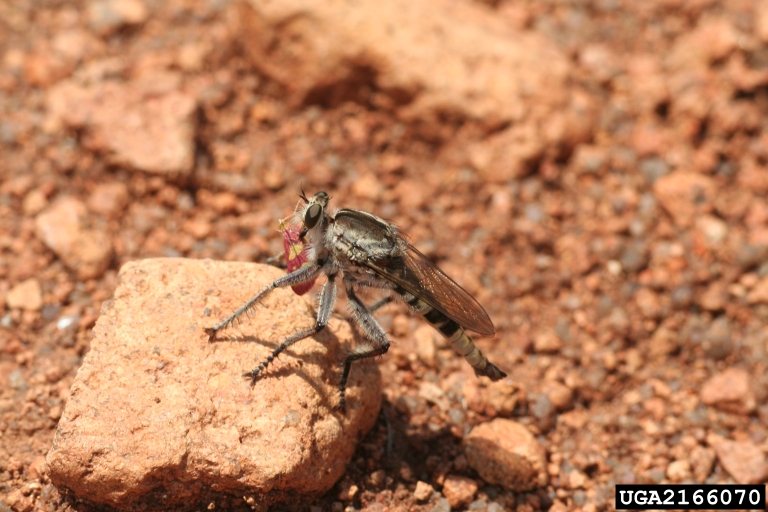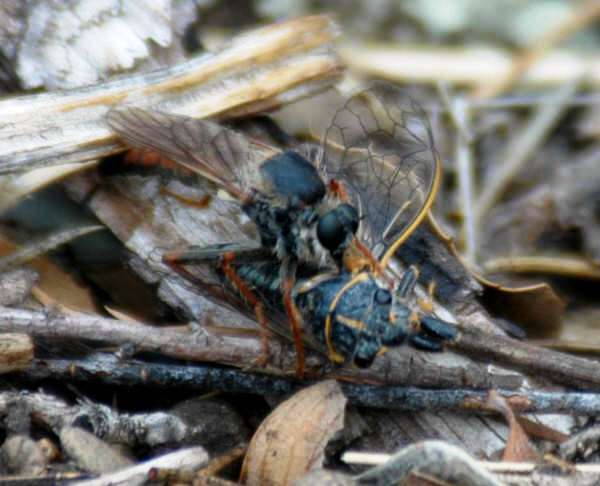 Robber Flies - September 3, 2014 Jeff Schalau, Agent, Agriculture & Natural Resources University of Arizona Cooperative Extension, Yavapai County Have you ever been relaxing next to an Arizona stream or river and all of a sudden felt a painful bite, slapped and killed the offender, and discovered it was a large fly? It might have been a robber fly. However, sometimes their eyes get bigger than their stomach and they try to take on a person. Luckily, they are not known to transmit disease and their bites can be treated as you would treat a minor scratch. The robber flies are a diverse family within the order Diptera (which includes flies and mosquitoes and means “two wings”) with close 1,000 species in North America. They are known for their predatory behavior and are common in riparian areas and sunny areas where prey insects congregate. Adult robber flies attack and feed on moths, butterflies, cicadas, wasps, bees, dragonflies, grasshoppers, other flies, some spiders, and a variety of other insects. Adult robber flies are medium to large (3/8 to 1-1/8 inch) flies that are often observed on stems of plants, on the ground or flying low. Species vary in appearance and some mimic wasps and bees. Most species are gray to black, hairy-bodied, have a long, narrow, tapering abdomen containing segments that may be banded, patterned or contrasting in color. The heads of adults have a depression between the large compound eyes when viewed from the front. Robber flies have long, strong legs that are bristled to aid in prey capture. Males and females are similar in appearance with females having slightly broader abdomens. Female robber flies deposit whitish-colored eggs on low-lying plants and grasses, or in crevices within soil, bark, or wood. Egg-laying habits depend on the species and their specific habitat; most species lay their eggs in masses, which are then covered with a chalky protective coating. After hatching, robber fly larvae live in the soil or in various other decaying organic materials that occur in their environment. Larvae are also predacious, feeding on eggs, larvae, or other soft-bodied insects. Robber flies overwinter as larvae and pupate in the soil. Pupae migrate to the soil surface and emerge as adults, often leaving behind their pupal casing. Complete development ranges from one to three years, depending on species and environmental conditions. Robber flies generally establish a perching zone in which to locate potential prey. Perching height varies by species, but generally occurs in open, sunny locations. Robber flies can seize their prey in flight and inject their victims with saliva containing neurotoxic and proteolytic enzymes. This injection rapidly immobilizes prey and digests bodily contents. The robber fly soon has access to a liquid meal, which is generally consumed upon returning to a perched position. Robber flies are not picky about their meals. This presents a dilemma to the informed gardener because they will dine indiscriminately on those insects we gardeners consider beneficial. On the other hand, they do eat harmful pests just as enthusiastically. Overall, robber flies are considered to play an important role in maintaining a healthy balance in our gardens and in wildland ecosystems. On a different note, be on the lookout for Texas root rot (Phymatotrichum omnivorum) also known as cotton root rot. It usually appears during the summer months. Infected plants usually fade quickly and often die with the leaves still attached. This plant disease can colonize a wide array of plant species and the only plants truly immune are the monocots (grasses, palms, bamboos, flower bulbs, onions, garlic, yuccas, agaves, and various others). There are many places in the Verde Valley where this root disease is known to occur. Diagnosis is possible with a good root sample and inspection under a dissecting microscope. The disease is in the soil and no treatment is known. Follow the Backyard Gardener on Twitter – use the link on the BYG website. If you have other gardening questions, call the Master Gardener help line in the Camp Verde office at 928-554-8999 Ext. 3 or e-mail us at verdevalleymg@gmail.com and be sure to include your name, address and phone number. Find past Backyard Gardener columns or provide feedback at the Backyard Gardener web site: http://cals.arizona.edu/yavapai/anr/hort/byg/. Photos  Robber fly (Triorla interrupta, Whitney Cranshaw, Colorado State University, Bugwood.org)
Robber fly (Triorla interrupta, Whitney Cranshaw, Colorado State University, Bugwood.org) Robber fly eating a cicada, Prescott, AZ, June 2007)
Robber fly eating a cicada, Prescott, AZ, June 2007) |